Formation Mechanism and Improvement of Magnetic Particle Inspection Defects in Cr5 Backup Roller Forged Ingot
Abstract
1. Introduction
2. Materials and Methods
2.1. Experimental Procedure
2.2. Analysis Method of Composition and Micro-Inspection
3. Results
3.1. Analysis of Defective Part on the Ingot
3.2. Characteristics of the Inclusions during the Metallurgical Process
4. Discussion
4.1. Formation Mechanism of the SiO2-MnO-Al2O3 Type Inclusions
4.2. Modification of the Liquid Oxide Inclusions
4.3. Optimization and Verification of Plant Trials
5. Conclusions
- (1)
- The linear and aggregating distribution of SiO2-MnO-Al2O3 inclusions up to 3 mm was the cause of the failure in flaw detection. The sizes of SiO2-MnO-Al2O3 were rather uneven. Besides, SiO2-MnO-Al2O3 inclusions with irregular plate strip shapes were uniformly distributed in composition.
- (2)
- SiO2-MnO-Al2O3 type inclusions were mainly formed in the over-oxidation environment during the IF melting. Owing to its low contact angles, large-size SiO2-MnO-Al2O3 inclusions in the defective area were inherited from the initial smelting process. CaO-SiO2-Al2O3 inclusions formed during the LF refining process were the dominating inclusions in the whole process.
- (3)
- The content of aluminum in the molten steel over 0.024% in Fe-5Cr back-up roller steel could suppress the formation of SiO2-MnO-Al2O3 liquid oxide during an over-oxidation environment. CaO-SiO2-Al2O3 liquid oxide inclusions could be completely modified as solid CaO-Al2O3 type inclusions over 0.02% aluminum content during the refining process. After the optimization, the amount and sizes of large-size liquid inclusions (>50 μm) decreased significantly before the VD refining.
Author Contributions
Funding
Institutional Review Board Statement
Informed Consent Statement
Data Availability Statement
Acknowledgments
Conflicts of Interest
References
- Yu, S.D.; Chen, H. Current Status and Several Problems of Roller Industry in China. Iron Steel 2007, 42, 1–6. [Google Scholar]
- Montmitonnet, P.; Buessler, P. A Review on Theoretical Analyses of Rolling in Europe. ISIJ Int. 1991, 31, 525–538. [Google Scholar] [CrossRef][Green Version]
- Gonzalez, W.B.; Llano, J.; García, J. Metallurgical Application to Work and Back Up Rolls for Hot & Cold Rolling of Flat Products; Rolls for Flat Rolling of Steel: Lugones, Spain, 2007. [Google Scholar]
- Mammeri, A.; Belzune, F.J.; Rodirguez, C.; Torre, M.; Poveda, S.; Garcia, J. Mechanical Properties of Chromium Steels for Back up Rolling Rolls. Rev. Metal. 2003, 39, 107–113. [Google Scholar] [CrossRef][Green Version]
- Nakagawa, Y.; Hashimoto, T.; Katayama, H.; Morikawa, H. Development of High-Cr Roll for Hot Strip Mill with Superior Resistance to Surface Deterioration and Spalling of Outer Shell. Tetsu-to-Hagane 1988, 74, 1993–2000. [Google Scholar] [CrossRef]
- Shimizu, M.; Shitamura, O.; Matsuo, S.; Kamata, T.; Kondo, Y. Development of High Performance New Composite Roll. ISIJ Int. 1992, 32, 1244–1249. [Google Scholar] [CrossRef]
- Di Schino, A.; Di Nunzio, P.E. Metallurgical Aspects Related to Contact Fatigue Phenomena in Steels for Back-Up Rolls. Acta Metall. Slovaca 2017, 23, 62–71. [Google Scholar] [CrossRef]
- Jia, R.; Li, X.D.; Li, J.C.; Gu, K. Present Research Situation on Cr5 Series Large Back-up Roll Process in China. Hot Work. Technol. 2013, 42, 62–65. [Google Scholar]
- Mccann, J. Overview of Work Rolls for Cold Rolling. Ironmak. Steelmak. 2000, 27, 15–18. [Google Scholar]
- Kang, X.; Li, D.; Xia, L.; Campbell, J.; Li, Y. Development of Cast Steel Back-up Roll. Int. J. Cast Met. Res. 2006, 19, 66–71. [Google Scholar] [CrossRef]
- Ichino, K.; Ishikawa, S.; Kataoka, Y.; Toyooka, T. Improvement of Hot Wear Characteristic of High Speed Tool Steel Roll by Increase in Cr and Mo Contents. Tetsu-to-Hagane 2003, 89, 680–685. [Google Scholar] [CrossRef][Green Version]
- Yu, H.; Ji, C.; Chen, B.; Wang, C.; Zhang, Y. Characteristics and Evolution of Inclusion Induced Surface Defects of Cold Rolled IF Sheet. J. Iron Steel Res. Int. 2015, 22, 17–23. [Google Scholar] [CrossRef]
- Sano, Y.; Hattori, T.; Haga, M. Characteristics of High-Carbon High Speed Steel Rolls for Hot Strip Mill. ISIJ Int. 1992, 32, 1194–1201. [Google Scholar] [CrossRef]
- Kobayashi, K. Technical View on Forged Steel Rolls in Japan. Tetsu-to-Hagane 1971, 57, 725–737. [Google Scholar] [CrossRef][Green Version]
- Chen, J.L. Development of Cr5 Forged Blank of Cold-Rollers. Forg. Stamp. Technol. 2006, 31, 10–12. [Google Scholar]
- Zhou, Q.; Zhang, J.; Yin, Y.; Zhai, M. Characterization of Inclusions in Axle Steel by Ingot Casting. Metall. Res. Technol. 2019, 116, 501–508. [Google Scholar] [CrossRef]
- Huang, H.G.; Du, F.S.; Zhang, F. FEM Analyses on Forming Mechanics of Inclusion Defects Inner Heavy Backup-Roll Forging. China Mech. Eng. 2009, 20, 477–481. [Google Scholar]
- Dong, B.L. Cause Analysis on Exposed Inclusion and Steel Melting Process Optimization of Backup Roll. Heavy Cast. Forg. 2019, 40, 46–48. [Google Scholar]
- Gotoh, K.; Okada, H.; Sasaki, T.; Koide, T. Effects of Roll Surface Deteriorations on Scale Defect in Hot Rolling. Tetsu-to-Hagane 1998, 84, 861–867. [Google Scholar] [CrossRef][Green Version]
- Takechi, H.; Namba, K.; Kawasaki, K.; Fujiwara, K. Evaluation of the Fatigue Damage of Rolls for Strip Mills below the Surface by X-ray Diffraction Method. Tetsu-to-Hagane 1979, 65, 2067–2075. [Google Scholar] [CrossRef]
- Ray, A.K.; Mishra, K.K.; Chaudhary, P.N. Failure Analysis of Rolls of Cold Rolling Mill in Steel Plant. In Failure Analysis, Proceedings of the Clinic on Failure Analysis, Jamshedpur, India, 18–19 February 1997; NML: Jamshedpur, India, 1997; pp. 37–46. [Google Scholar]
- Wang, R.; Bao, Y.; Li, Y.; Yan, Z.; Li, D.; Kang, Y. Influence of Metallurgical Processing Parameters on Defects in Cold-Rolled Steel Sheet Caused by Inclusions. Int. J. Miner. Metall. Mater. 2019, 26, 440–446. [Google Scholar] [CrossRef]
- Wang, Q.; Li, Z.; Shi, Y.; Wang, L.; Liu, F. Interior Crack and Its Formation Mechanism in Overlaying Weld of Back-up Rolls. Eng. Fail. Anal. 2013, 34, 268–277. [Google Scholar] [CrossRef]
- Jamil, M.; Khan, A.M.; Hegab, H.; Sarfraz, S.; Sharma, N.; Mia, M.; Gupta, M.K.; Zhao, G.; Moustabchir, H.; Pruncu, C.I. Internal Cracks and Non-Metallic Inclusions as Root Causes of Casting Failure in Sugar Mill Roller Shafts. Materials 2019, 12, 2474. [Google Scholar] [CrossRef] [PubMed]
- Lu, J.; Cheng, G.; Wu, M.; Yang, G.; Che, J. Detection and Analysis of Magnetic Particle Testing Defects on Heavy Truck Crankshaft Manufactured by Microalloyed Medium-Carbon Forging Steel. J. Iron Steel Res. Int. 2020, 27, 608–616. [Google Scholar] [CrossRef]
- Wang, Q.; Cheng, G.; Li, J.; Dou, W.; Hu, X. Formation Mechanism of Large Inclusions in 80t 20Cr–8Ni Stainless Steel Casting for Nuclear Power. Steel Res. Int. 2019, 90, 1900349. [Google Scholar] [CrossRef]
- Goto, K.; Matsuda, Y.; Sakamoto, K.; Sugimoto, Y. Basic Characteristics and Microstructure of High-Carbon High Speed Steel Rolls for Hot Rolling Mill. ISIJ Int. 1992, 32, 1184–1189. [Google Scholar] [CrossRef]
- Lee, W.-H.; Liu, Y. Laboratory Evaluation of New Type of Backup Roll for Strip Shape Control. ISIJ Int. 2005, 45, 1636–1640. [Google Scholar] [CrossRef]
- Prasad, M.S.; Ray, A.; Dhua, S.K.; Avtar, R.; Jha, S. Premature Failure of Work-Rolls in Tandem Mill: Some Microstructural Revelations. J. Fail. Anal. Prev. 2004, 4, 67–72. [Google Scholar] [CrossRef]
- Kimura, T.; Ishii, M.; Amano, K.; Ueda, S.; Oka, Y.; Nakano, S. Secondary Hardening Characteristics and Those Effects on the Wear and Thermal Shock Resistance of 5%Cr-Mo-V Steel Roll for Cold Strip Mill. ISIJ Int. 1992, 32, 1224–1231. [Google Scholar] [CrossRef][Green Version]
- Parry, G.; Ostrovski, O. Wetting of Solid Iron, Nickel and Platinum by Liquid MnO–SiO2 and CaO–Al2O3–SiO2. ISIJ Int. 2009, 49, 788–795. [Google Scholar] [CrossRef]
- Vantilt, S.; Coletti, B.; Blanpain, B.; Fransaer, J.; Wollants, P.; Sridhar, S. Observation of Inclusions in Manganese-Silicon Killed Steels at Steel-Gas and Steel-Slag Interfaces. ISIJ Int. 2004, 44, 1–10. [Google Scholar] [CrossRef]
- Wang, K.; Jiang, M.; Wang, X.; Wang, Y.; Zhao, H.; Cao, Z. Formation Mechanism of SiO2-Type Inclusions in Si-Mn-Killed Steel Wires Containing Limited Aluminum Content. Metall. Mater. Trans. B 2015, 46, 2198–2207. [Google Scholar] [CrossRef]
- Shinozaki, N.; Echida, N.; Mukai, K.; Takahashi, Y.; Tanaka, Y. Wettability of Al2O3-MgO, ZrO2-CaO, Al2O3-CaO Substrates with Molten Iron. Tetsu-to-Hagane 1994, 80, 748–753. [Google Scholar] [CrossRef]
- Van Ende, M.-A.; Guo, M.; Proost, J.; Blanpain, B.; Wollants, P. Formation and Morphology of Al2O3 Inclusions at the Onset of Liquid Fe Deoxidation by Al Addition. ISIJ Int. 2011, 51, 27–34. [Google Scholar] [CrossRef]
- Kapilashrami, E.; Sahajwalla, V.; Seetharaman, S. Investigation of the Wetting Characteristics of Liquid Iron on Mullite by Sessile Drop Technique. ISIJ Int. 2004, 44, 653–659. [Google Scholar] [CrossRef]
- O’Malley, R.J. Inclusion Evolution and Removal in Ladle Refining; Missouri University of Science & Technology: Rolla, MO, USA, 2017. [Google Scholar]
- Wu, S.; Guo, X.; Wang, Y.; Wu, G.; Lyu, S. Laboratory Study on Evolution Mechanism of Nonmetallic Inclusions in Al-Deoxidized Spring Steel. Trans. Indian Inst. Met. 2020, 73, 2807–2816. [Google Scholar] [CrossRef]
- Kawakami, K.; Taniguchi, T.; Nakashima, K. Generation Mechanisms of Non-Metallic Inclusions in High-Cleanliness Steel. Tetsu-to-Hagane 2007, 93, 743–752. [Google Scholar] [CrossRef]
- Deng, Z.; Zhu, M. Deoxidation Mechanism of Al-Killed Steel during Industrial Refining Process. ISIJ Int. 2014, 54, 1498–1506. [Google Scholar] [CrossRef]
- Miao, Z.; Cheng, G.; Li, S.; Qiu, W.; Zeng, L.; Long, H. Formation Mechanism of Large-Size CaO–Al2O3–MgO–SiO2 Inclusions in High Carbon Chromium Bearing Steel. ISIJ Int. 2021, 61, 2083–2091. [Google Scholar] [CrossRef]

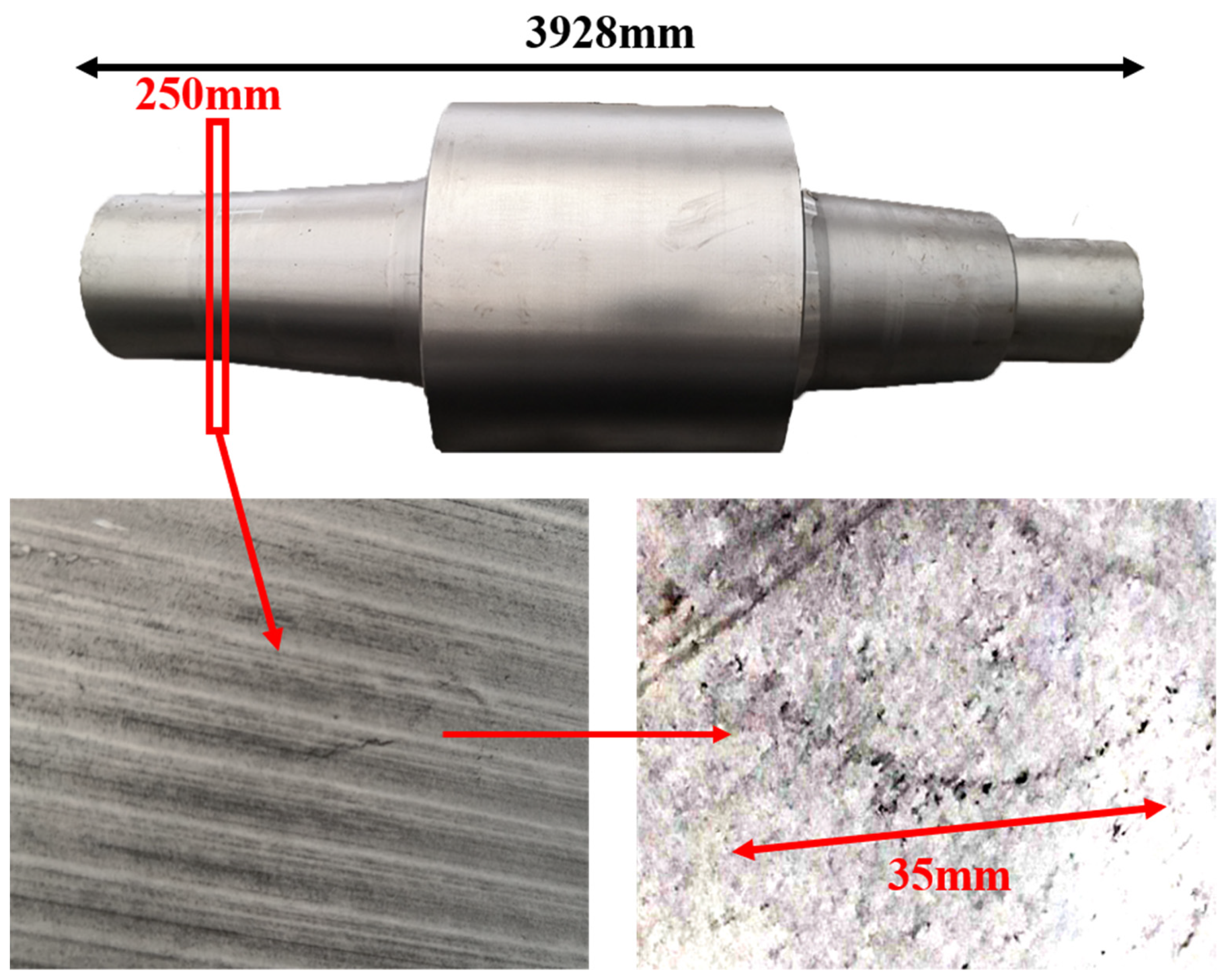



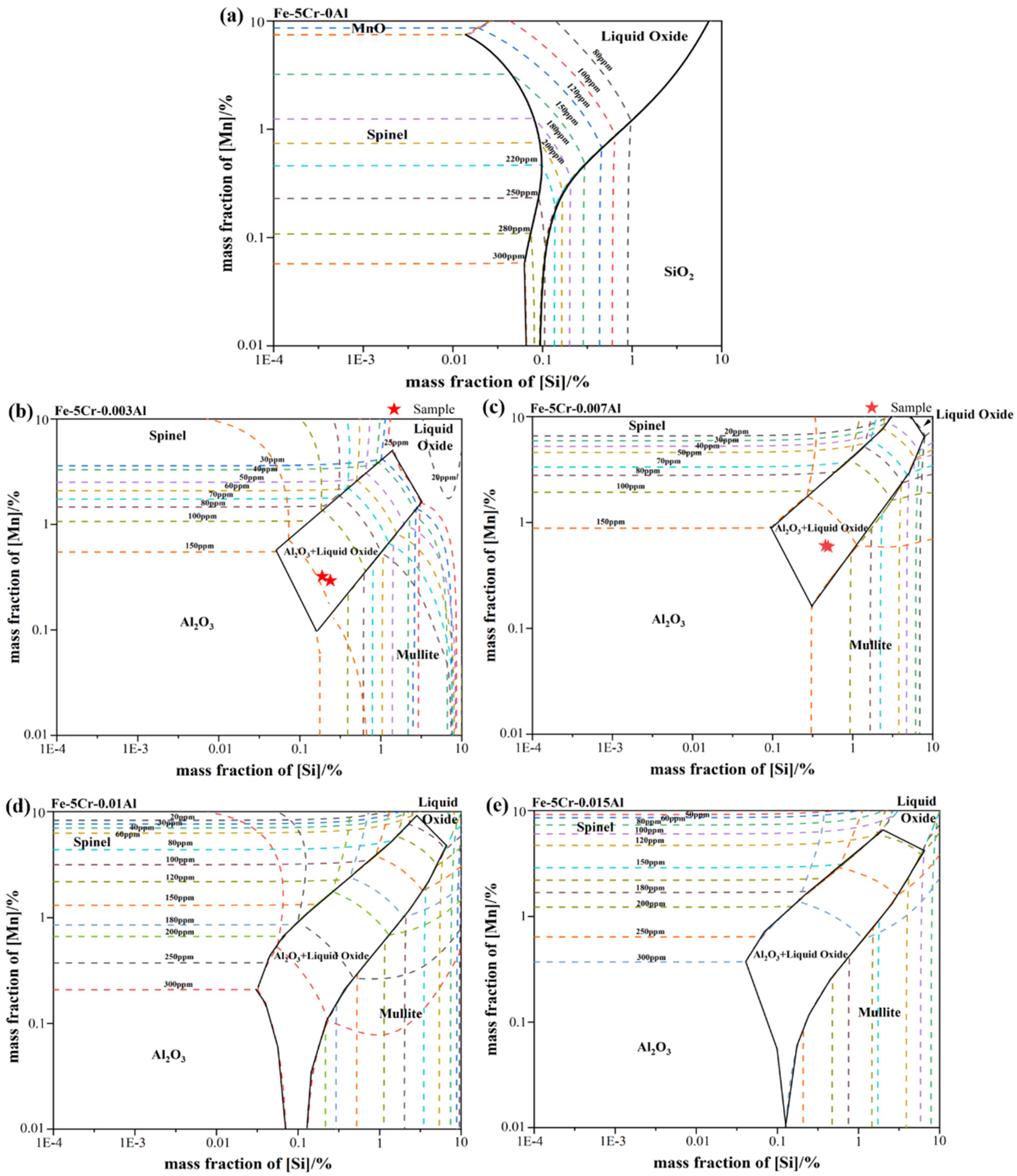
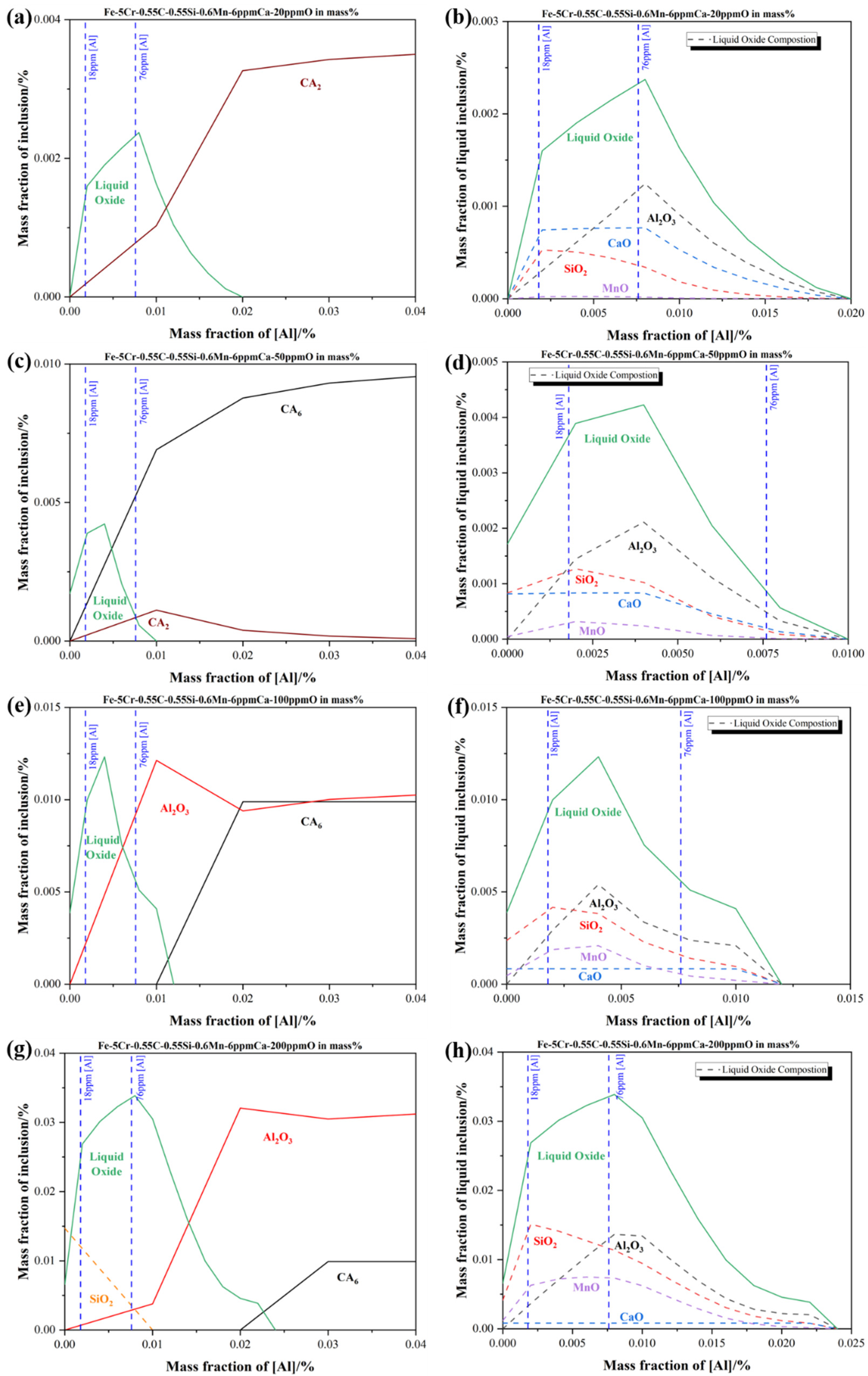

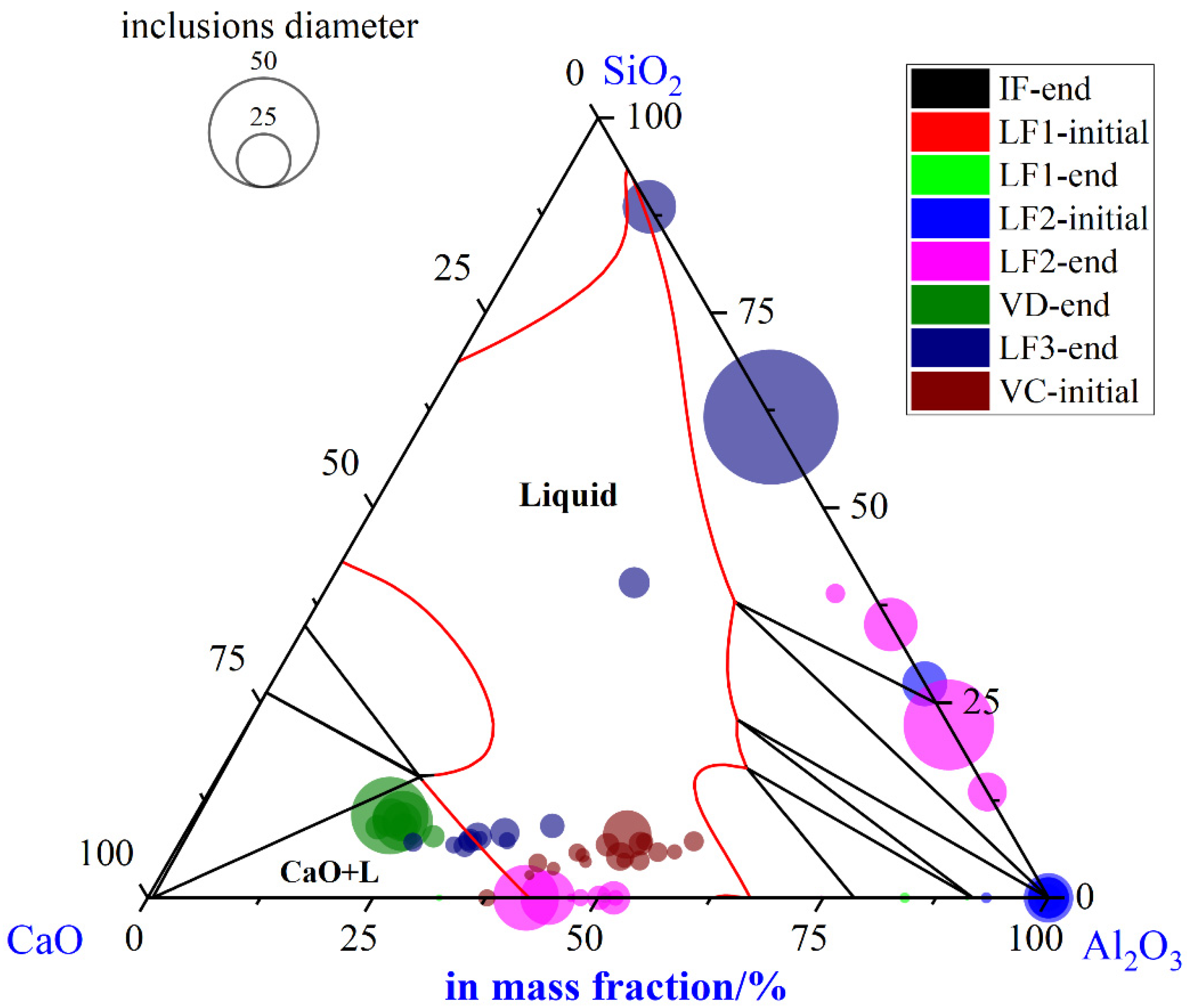
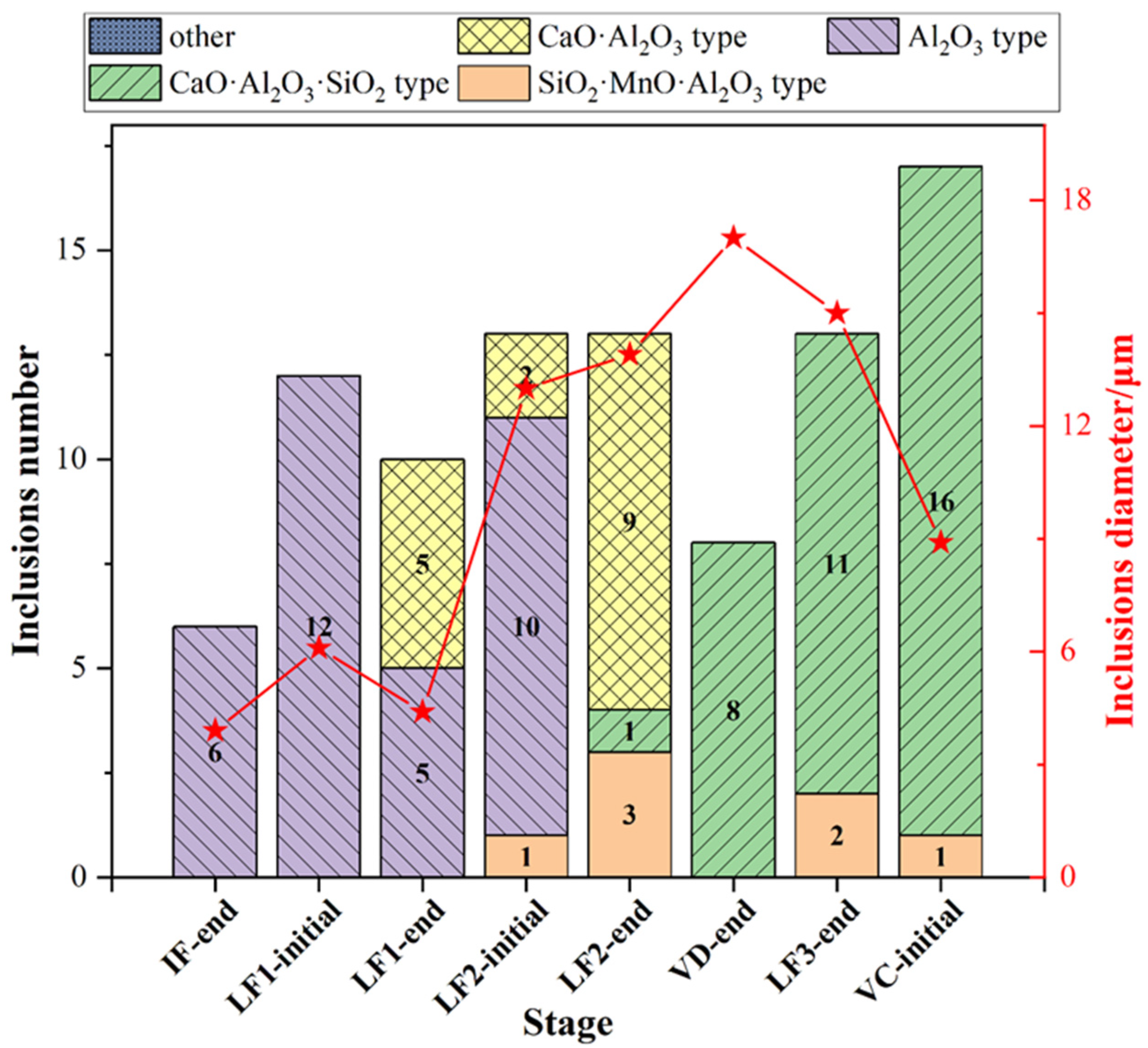
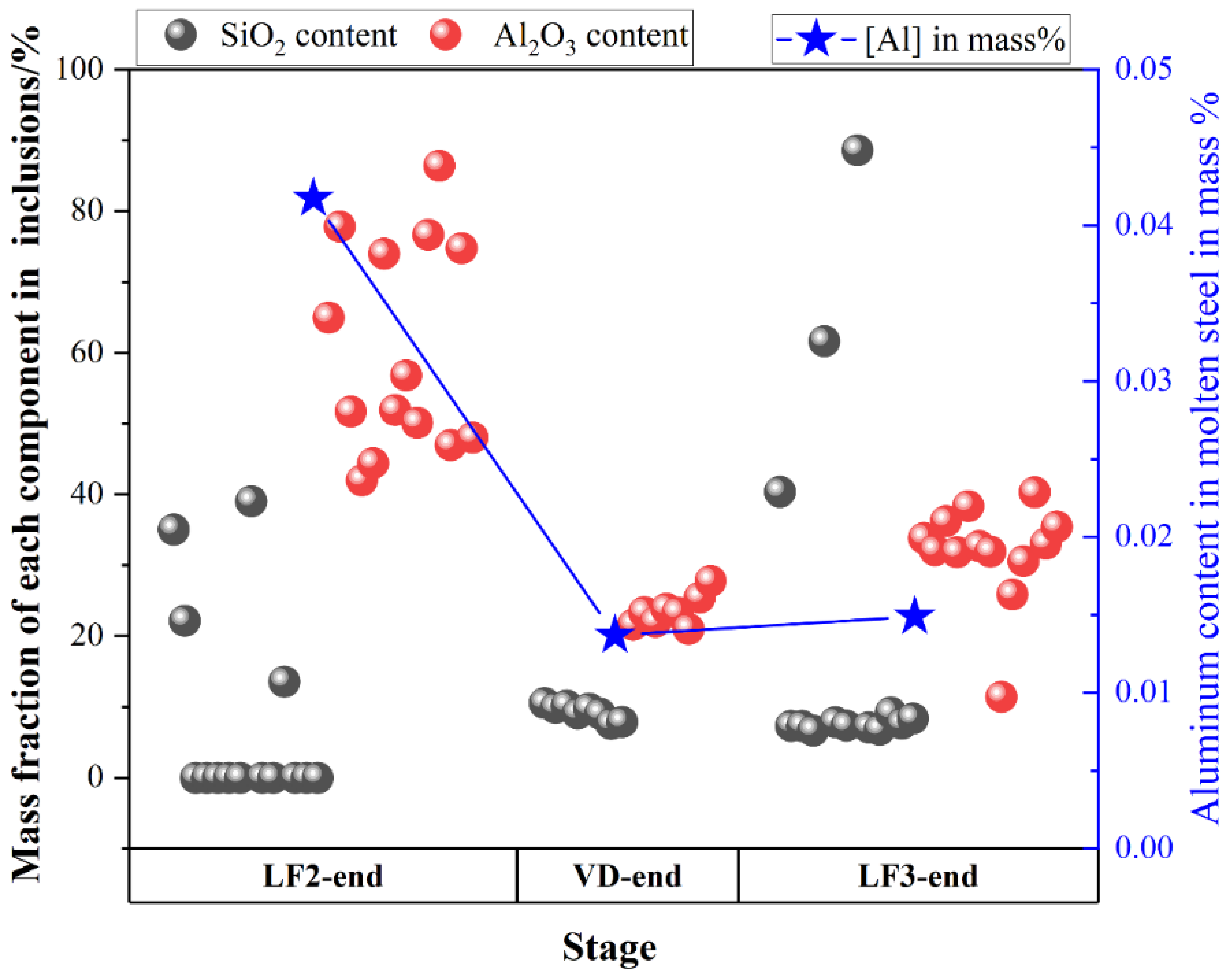
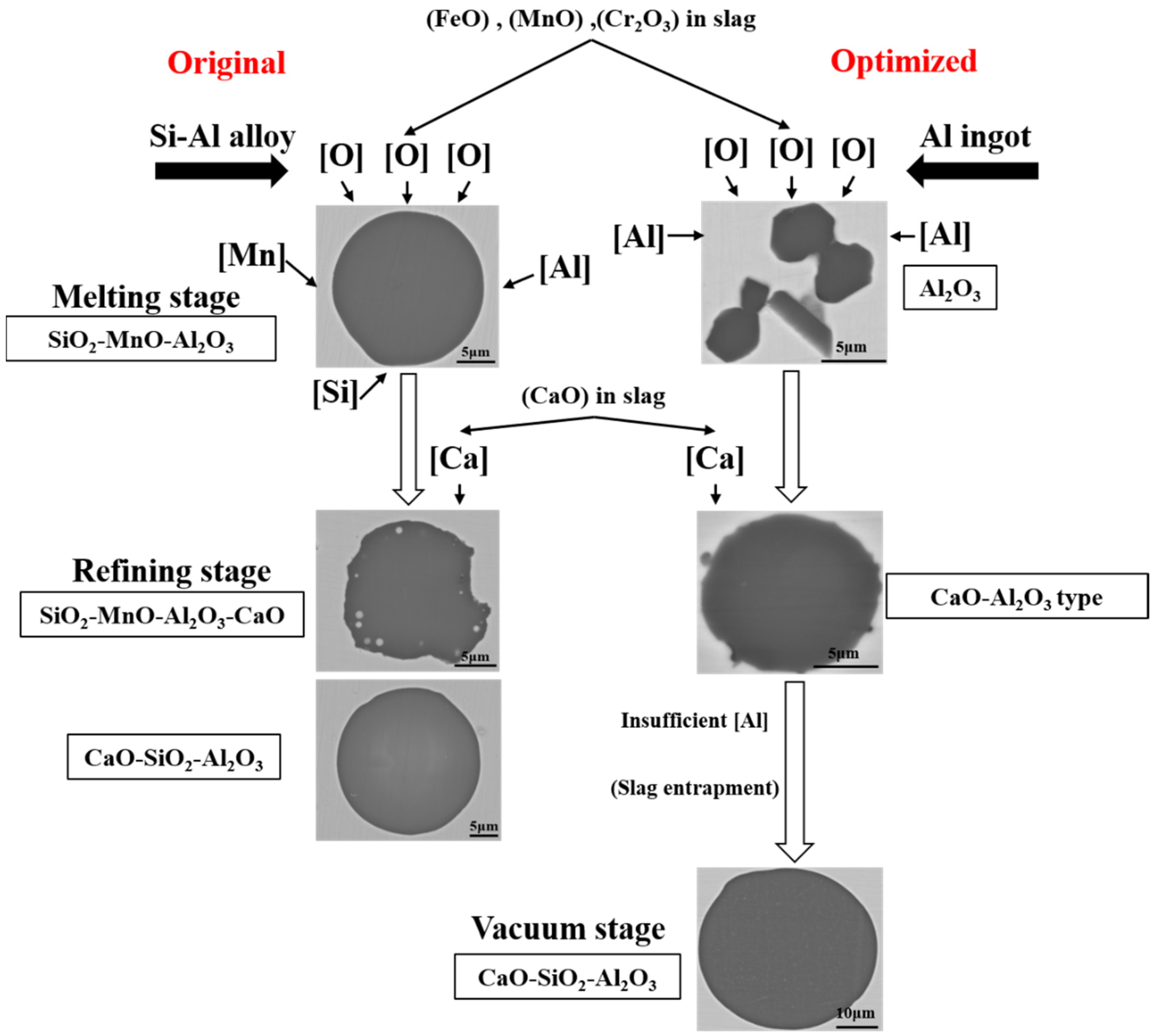
| Specimen No. | Stage | C/% | Si/% | Mn/% | P/% | S/% | Cr/% | Al/% | Ca/% | O/% |
|---|---|---|---|---|---|---|---|---|---|---|
| A1 | IF-end | 0.407 | 0.23 | 0.29 | 0.0095 | 0.0034 | 3.32 | 0.0018 | 0.0003 | 0.0242 |
| A2 | LF1-initial | 0.422 | 0.22 | 0.29 | 0.0092 | 0.0034 | 3.27 | 0.0015 | 0.0008 | 0.0285 |
| A3 | LF1-end | 0.433 | 0.19 | 0.32 | 0.0098 | 0.0025 | 3.30 | 0.0036 | 0.0003 | 0.0045 |
| A4 | LF2-initial | 0.423 | 0.17 | 0.32 | 0.0098 | 0.003 | 3.24 | 0.0032 | 0.0003 | 0.0067 |
| A5 | LF2-end | 0.519 | 0.49 | 0.60 | 0.0113 | 0.0005 | 5.20 | 0.0076 | 0.0062 | 0.0021 |
| A6 | VD-end | 0.539 | 0.46 | 0.60 | 0.0112 | 0.0004 | 5.20 | 0.0063 | 0.0012 | 0.0022 |
| A7 | LF3-end | 0.538 | 0.47 | 0.60 | 0.0113 | 0.0004 | 5.25 | 0.0067 | 0.0017 | 0.0017 |
| A8 | VC- initial | 0.536 | 0.47 | 0.60 | 0.0117 | 0.0006 | 5.27 | 0.0062 | 0.0006 | 0.002 |
| Specimen No. | Stage | CaO | SiO2 | Al2O3 | MnO | Cr2O3 | FeO | CaF2 |
|---|---|---|---|---|---|---|---|---|
| A1 | IF-end | 5.91 | 46.30 | 19.90 | 13.30 | 6.08 | 3.51 | 0.17 |
| A2 | LF1-initial | 6.62 | 42.20 | 19.10 | 11.70 | 7.19 | 3.63 | 0.32 |
| A3 | LF1-end | 63.17 | 19.40 | 6.48 | 0.16 | 0.14 | 0.48 | 3.86 |
| A4 | LF2-initial | — | — | — | — | — | — | — |
| A5 | LF2-end | 61.69 | 19.30 | 4.55 | 0.03 | 0.04 | 0.25 | 8.07 |
| A6 | VD-end | 58.91 | 20.80 | 6.51 | 0.02 | 0.03 | 0.16 | 7.06 |
| A7 | LF3-end | 58.25 | 19.10 | 6.99 | 0.04 | 0.05 | 0.38 | 7.98 |
| A8 | VC- initial | 57.83 | 19.10 | 6.50 | 2.30 | 0.05 | 0.35 | 7.59 |
| Sample No. | Stage | Main Inclusions | Minor Inclusions | ||
|---|---|---|---|---|---|
| Morphology | Type wt.% | Morphology | Type wt.% | ||
| A1 | IF-end | 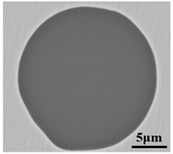 | SiO2-(48.0%) MnO-(22.3%) Al2O3-(29.6%) |  | SiO2-(72.4%) MnO-(18.6%) Al2O3-(0.09%) |
| A2 | LF1-intial | 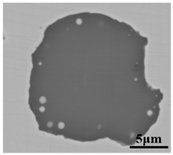 | SiO2-(28.2%) MnO-(14.2%) Al2O3-(46.5%) CaO-(10.5%) | 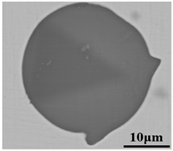 | SiO2-(58.1%) MnO-(12.3%) Al2O3-(29.6%) |
| A3 | LF1-end | 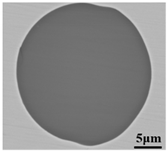 | CaO-(11.2%) SiO2-(49.3%) Al2O3-(39.5%) |  | CaO-(50.7%) SiO2-(33.6%) Al2O3-(15.7%) |
| A4 | LF2- initial |  | CaO-(24.4%) SiO2-(24.4%) Al2O3-(51.2%) | 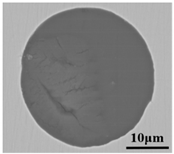 | CaO-(36.2%) SiO2-(26.9%) Al2O3-(36.9%) |
| A5 | LF2-end |  | CaO-(79.0%) SiO2-(10.0%) Al2O3-(11%) |  | SiO2-(42.0%) MnO-(22.5%) Al2O3-(35.0%) |
| A6 | VD-end | 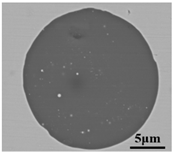 | SiO2-(72.5%) MnO-(22.3%) Al2O3-(5.1%) |  | CaO-(75.7%) SiO2-(18.5%) Al2O3-(5.9%) |
| A7 | LF3-end |  | CaO-(63.8%) SiO2-(18.2%) Al2O3-(18.0%) |  | SiO2-(25.0%) MnO-(22.3%) Al2O3-(54.2%) |
| A8 | VC-initial | 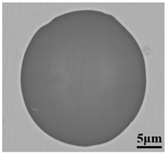 | CaO-(52.6%) SiO2-(12.6%) Al2O3-(34.8%) |  | SiO2-(15.0%) MnO-(12.3%) Al2O3-(72.5%) |
| Specimen No. | Stage | CaO | SiO2 | Al2O3 | MnO | Cr2O3 | FeO | CaF2 |
|---|---|---|---|---|---|---|---|---|
| B1 | IF-end | 0.99 | 41.00 | 19.00 | 20.40 | 10.00 | 3.82 | 0.00 |
| B2 | LF1-initial | 2.36 | 31.80 | 36.50 | 13.60 | 6.51 | 3.90 | 0.08 |
| B3 | LF1-end | 62.79 | 16.70 | 10.60 | 0.20 | 0.15 | 0.57 | 4.19 |
| B4 | LF2-initial | — | — | — | — | — | — | — |
| B5 | LF2-end | 54.39 | 12.00 | 23.20 | 0.15 | 0.20 | 1.07 | 2.24 |
| B6 | VD-end | 53.07 | 11.30 | 24.50 | 0.05 | 0.10 | 0.47 | 2.13 |
| B7 | LF3-end | 53.33 | 11.10 | 24.80 | 0.05 | 0.10 | 0.46 | 1.97 |
| B8 | VC- initial | 52.88 | 11.00 | 25.20 | 0.07 | 0.12 | 0.80 | 2.01 |
| Specimen No. | Stage | Main Inclusions | |
|---|---|---|---|
| Morphology | Type wt.% | ||
| B1 | IF-end | 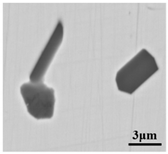 | Al2O3 |
| B2 | LF1-initial | 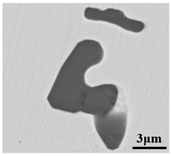 | Al2O3 |
| B3 | LF1-end | 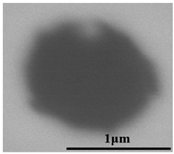 | CaO-(11.2%) Al2O3-(83.2%) |
| B4 | LF2-initial | 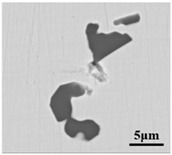 | Al2O3 |
| B5 | LF2-end |  | CaO-(57.6%) Al2O3-(40.2%) |
| B6 | VD-end |  | CaO-(66.5%) SiO2-(8.6%) Al2O3-(25.9%) |
| B7 | LF3-end | 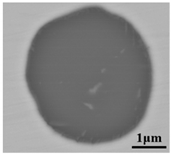 | CaO-(55.8%) SiO2-(9.2%) Al2O3-(36.0%) |
| B8 | VC-initial | 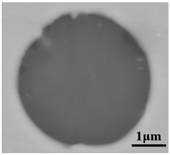 | CaO-(40.9%) SiO2-(6.4%) Al2O3-(52.7%) |
Publisher’s Note: MDPI stays neutral with regard to jurisdictional claims in published maps and institutional affiliations. |
© 2022 by the authors. Licensee MDPI, Basel, Switzerland. This article is an open access article distributed under the terms and conditions of the Creative Commons Attribution (CC BY) license (https://creativecommons.org/licenses/by/4.0/).
Share and Cite
Zhang, W.; Wang, G.; Zhang, Y.; Cheng, G.; Zhan, Z. Formation Mechanism and Improvement of Magnetic Particle Inspection Defects in Cr5 Backup Roller Forged Ingot. Metals 2022, 12, 295. https://doi.org/10.3390/met12020295
Zhang W, Wang G, Zhang Y, Cheng G, Zhan Z. Formation Mechanism and Improvement of Magnetic Particle Inspection Defects in Cr5 Backup Roller Forged Ingot. Metals. 2022; 12(2):295. https://doi.org/10.3390/met12020295
Chicago/Turabian StyleZhang, Weifeng, Guanbo Wang, Yanling Zhang, Guoguang Cheng, and Zhonghua Zhan. 2022. "Formation Mechanism and Improvement of Magnetic Particle Inspection Defects in Cr5 Backup Roller Forged Ingot" Metals 12, no. 2: 295. https://doi.org/10.3390/met12020295
APA StyleZhang, W., Wang, G., Zhang, Y., Cheng, G., & Zhan, Z. (2022). Formation Mechanism and Improvement of Magnetic Particle Inspection Defects in Cr5 Backup Roller Forged Ingot. Metals, 12(2), 295. https://doi.org/10.3390/met12020295







